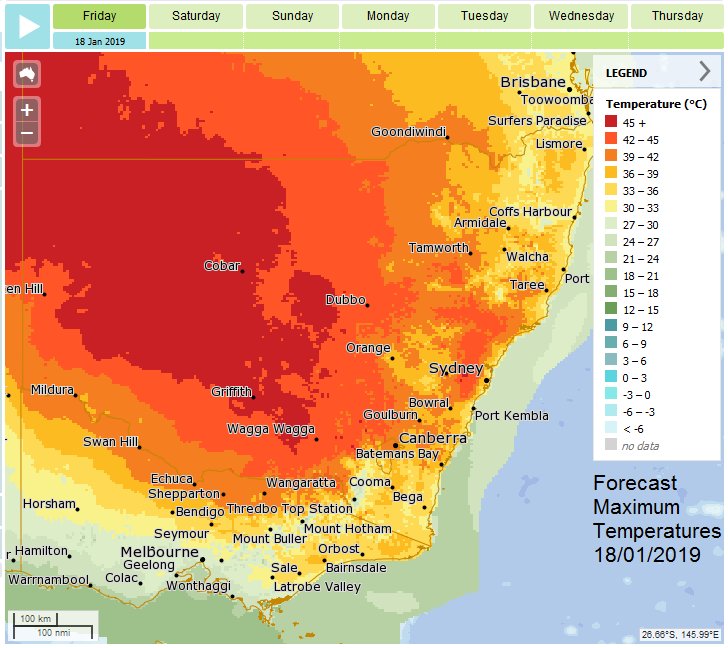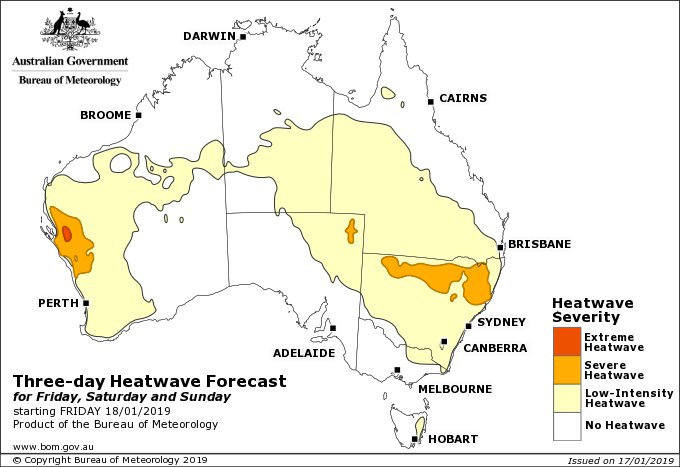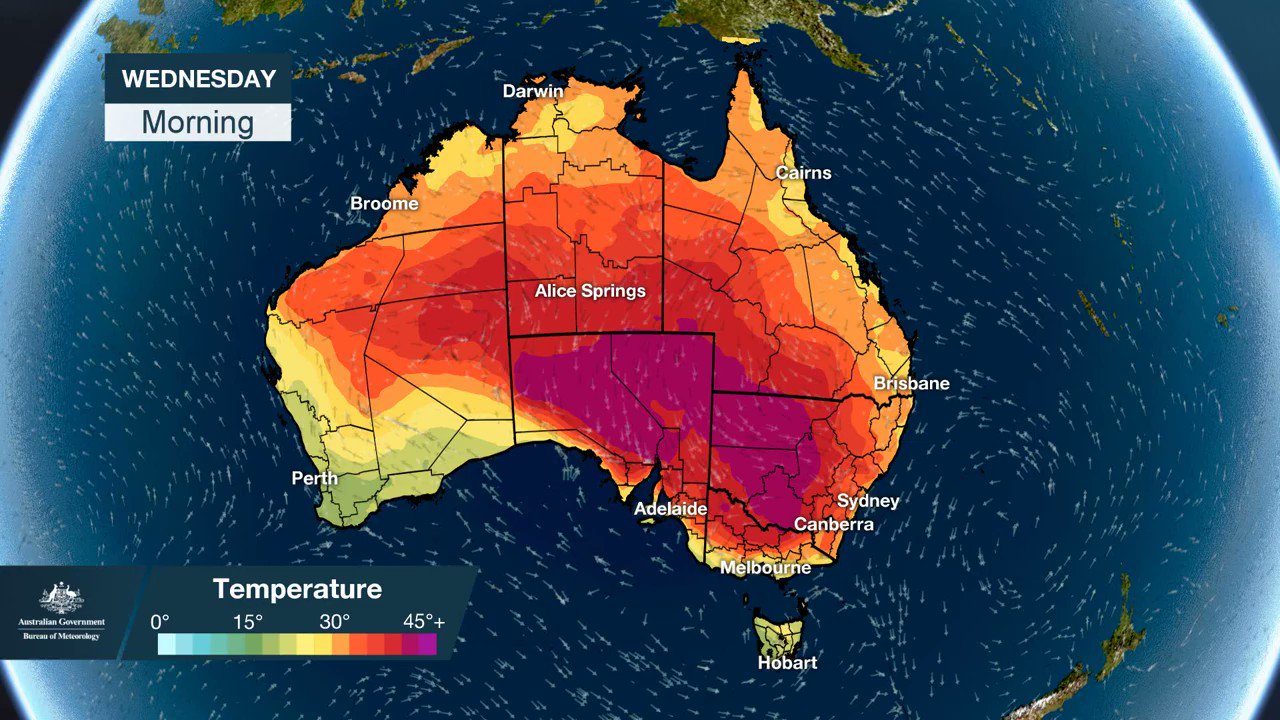Australia suffers through searing temperatures as heatwave reaches its peak
(CNN)An extreme heatwave already breaking records across Australia is expected to peak in many parts of the country Friday, with temperatures forecast to stay above 40 degrees Celsius (104 F) for the sixth day in a row.
The six days from January 12 to 17 are all within Australia's ten hottest days on record, the Australian Bureau of Meteorology said.
Marble Bar in northwestern Australia hit the highest temperature during the heatwave at a sweltering 49.1 C (120 F) on Sunday -- a January record for the area. The town had seen more than 20 consecutive days of temperatures above 40 C (104 F).
On Wednesday, New South Wales broke 14 heat records and eight January records. Conditions are so hot in the state that asphalt roads are starting to melt, CNN affiliate Nine News reported.
Records across South Australia, New South Wales and Victoria over the past week include 48.9 C (120 F) in Port Augusta, 47.8 C (118 F) in Andamooka and 46.4 C (115 F) in Griffith.
"Based on the extent and duration, this is the most significant heatwave to have affected inland eastern Australia since January 1939," Simon Grainger, Bureau of Meteorology climatologist, told CNN.
And it's not just the highs that are making people sweat. Noona in western New South Wales broke an all time "minimum temperature" record Thursday night, with the heat levels remaining above 35.9 C (96 F) throughout the night, according to the Australian Bureau of Meteorology.
Hot weather continues today, however temps in southern parts to drop by 5-10C tomorrow with a weak cool change. Low intensity #heatwave expected to continue into the new week. Stay cool and #beattheheat
Check the forecast: http://ow.ly/qtnJ30nm838
Warnings: http://ow.ly/r3rU30nm839
27 people are talking about this
While inland areas in New South Wales and Queensland are expected to see the mercury rise once again on Friday, cooler temperatures are expected to bring relief to parts of South Australia according to the BOM.
The town of Tarcoola in South Australia, which reached a sweltering 49 C (120 F) on Tuesday, is forecast to cool off slightly to 31 C (87 F) Friday.
As the protracted heatwave continues, concerns are with the vulnerable, including the young, elderly and those with asthma or respiratory diseases.
High ozone levels
On Wednesday, New South Wales Health authorities warned that the high temperatures are expected to contribute to "high ozone" air pollution across Sydney.
Dr. Richard Broome, director of environmental health at New South Wales Health, said thatpeople with asthma and other respiratory problems were particularly vulnerable as ozone "can irritate the lungs."
"Ozone levels are higher outdoors than indoors, and generally highest in the afternoon and early evening, so limiting time outdoors during the heat of the day and in the evening helps people to not only keep cool but to limit their exposure to ozone pollution," he said.
A health warning was in place across New South Wales from Tuesday, warning people to stay indoors during the hottest part of the day, minimize physical activity and keep hydrated.
"Signs of heat-related illness include dizziness, tiredness, irritability, thirst, fainting, muscle pains or cramps, headache, changes in skin color, rapid pulse, shallow breathing, vomiting and confusion," the statement said.
The past 4 days are in Australia's top 10 warmest days on record—and the trend looks like continuing today. The nights have been warm too, which is what defines #heatwave conditions http://ow.ly/LKhV30nkqMR Stay cool, check on loved ones & follow advice from health authorities
862 people are talking about this
It's the second heatwave to hit Australia in less than a month. Just over two weeks ago, brutal post-Christmas temperatures led to extreme or severe fire warnings across at least three states and intensified severe droughts across the country.
Fish, bat deaths and fruit cooking from the inside
The high temperatures are taking an increasing toll on the country's flora and fauna. In the Murray-Darling River Basin across the southeast, more than a million dead fish have washed up on the banks.
Niall Blair, primary industries minister in New South Wales, said more deaths of marine life are expected in coming days as temperatures continue to rise, according to local media.
But environmental activists have blamed the mass deaths on poor management of the river system by state and federal governments, alleging mass consumption of water by farmers was leaving too little for fish to survive.
"A lack of water in the Darling River and the Menindee Lakes means that authorities were unable to flush the system before millions of fish suffocated through a lack of oxygen in water," independent New South Wales lawmaker Jeremy Buckingham said in a statement.
"This mass fish kill should be a wake up call for Australia."

Dozens of fish lying dead on the Darling River in New South Wales near Menindee after an extreme heat wave in January.
Colonies of bats were also succumbing to the heat and dropping from trees in Adelaide, according to CNN affiliate Nine News, prompting warnings to avoid contact with the animals as they can carry deadly diseases.
Heat can be disastrous for bat species. Following a heatwave in north Queensland in November, an estimated 23,000 spectacled flying foxes died.
In South Australia, the extreme heat is causing stone fruit, including peaches and nectarines, to cook from the inside out, leading to heavy losses for farmers and spurring a race against time to harvest the fruit before it spoils, according to ABC.
"The stone burns them, which means they burn on the inside, they become squashy and you can't use them," Dried Tree Fruits Australia chairman Kris Werner told ABC.
It comes as the Australian Open kicked off in Melbourne at the Rod Laver Arena, in temperatures which topped 30 C (86 F).
It is the second year in a row of extreme temperatures at the Grand Slam event, with some competitors collapsing or complaining of heatstroke in the 2018 event.
Climate change taking its toll
January is typically the hottest month of the Australian summer and temperatures across the board have been higher in the country in recent years.
A report released by the Bureau of Meteorology on Thursday revealed 2018 was the country's third hottest year on record, with rainfall 11% below average.
Australia's winter last year saw the worst drought in living memory hit part of the country in August, destroying farmers' livelihoods as farmland turned dry and barren.
Even as Australia has suffered the effects of ongoing climate change, the government drags its feet on crafting a comprehensive environmental policy.
Despite a report from the Intergovernmental Panel on Climate Change warning of "global catastrophe" should world temperatures rise above 1.5 C (34 F) by the middle of the next decade, Prime Minister Scott Morrison's administration has refused to phase out the use of coal-fired power.
CNN's James Griffiths contributing
end quote from:
https://www.cnn.com/2019/01/18/australia/australia-heat-wave-peak-intl/


























No comments:
Post a Comment